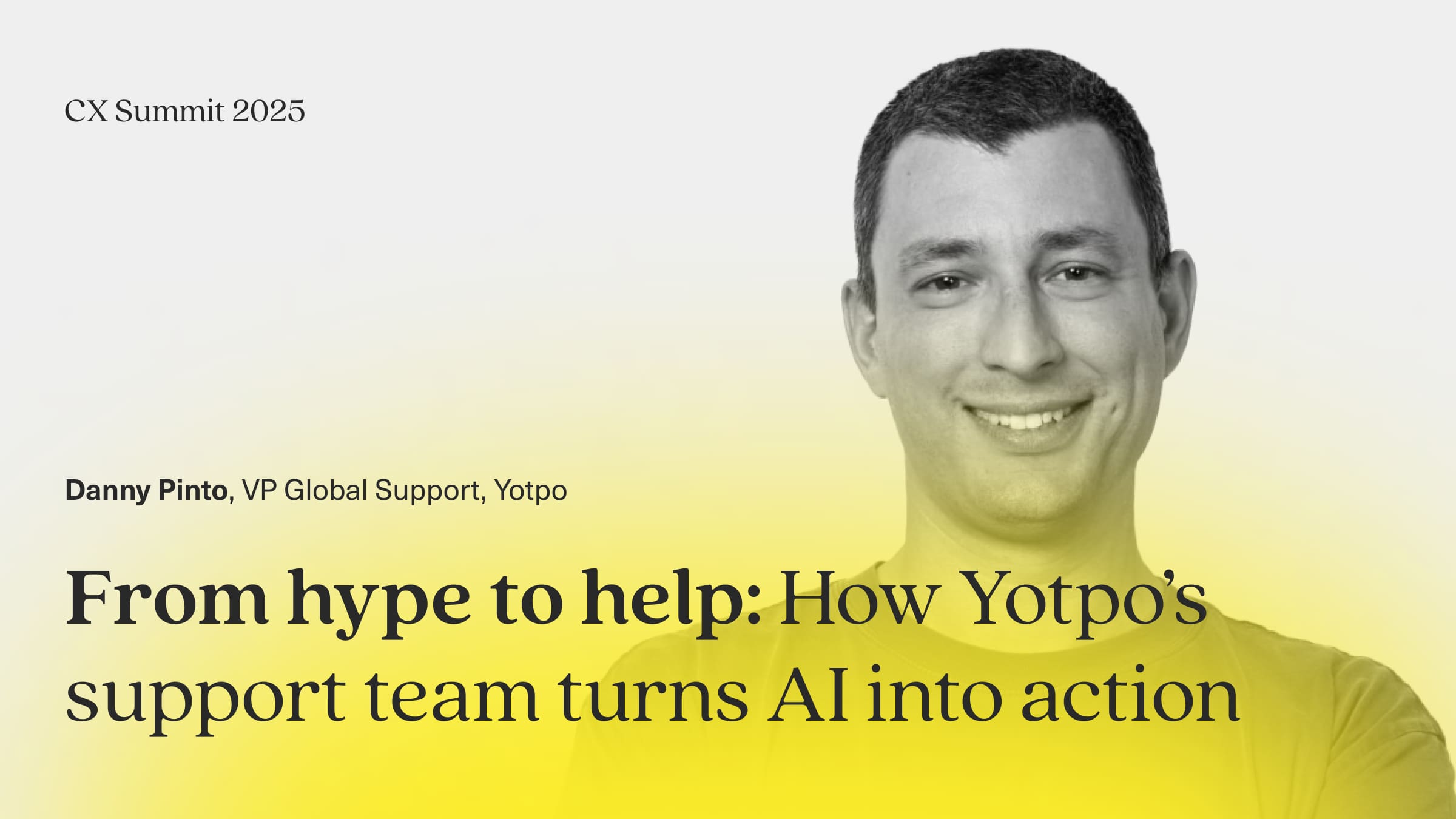In this conversation, Danny Pinto, a CX leader at Yotpo, shares how AI is reshaping the future of customer service—from smarter chatbots to proactive QA and real-time sentiment tracking. With a focus on starting small, building thoughtfully, and keeping the human touch intact, Danny outlines how brands can use AI to not just deflect incoming customer conversations, but truly elevate the customer experience.
Dig in to his expertise:
This interview has been edited for clarity.
Gabe Larsen: The world feels so different than even just a few days ago. Let’s dive in high level. When it comes to AI and customer service, what is your big-picture take? Is it making things better, worse—what is really happening?
Danny Pinto: The opportunities are endless, but one thing we struggled with initially is moving from talking about AI to actually implementing it in daily work. What we learned is not to do too many things at once. Focus first on achieving real adoption and specific results before jumping into the next project.
AI, like SAP, can answer so many questions, but you need to pinpoint the real pain you want to solve first. From there, decide what to prioritize next. At Yotpo, we have seen great results with chatbots, particularly allowing agents to focus on more complex tasks AI cannot yet handle.
Gabe: Let’s double-click into a couple of these areas. A lot of people feel overwhelmed when it comes to AI. Where do you think organizations should start? What is the low-hanging fruit?
Danny: There are three areas. First is chat, which is the obvious one—using AI to answer "how-to" questions. You do need a good help center to feed the AI.
Second is QA, quality assurance. This is usually very manual, and AI can review large volumes of interactions to find learning opportunities.
Third is your knowledge base. You know what you have written, but it is hard to know what is missing. AI can connect customer interactions to knowledge gaps, helping you create better help articles so customers can find answers on their own.
Gabe: Let’s dive deeper into chat. You mentioned knowledge base strength matters. What else have you seen around optimizing AI usage in the chat landscape?
Danny: On the chatbot side, there are two layers. The first is answering simple "how-to" questions, but that only gets you so far—maybe around 40% deflection depending on your business.
To really level up, you need to allow your bot to take actions, like importing data for a customer. That requires backend infrastructure to connect your bot to your systems securely.
We are now entering that phase at Yotpo. Taking actions adds more risk, but it is necessary if you want to push beyond basic deflection and drive real automation.
Gabe: Do you think there is a "layer three" coming?
Danny: Definitely. I think the third stage is letting AI troubleshoot on its own. For example, if a customer says their loyalty points balance is wrong, today an agent has to troubleshoot that. But if AI understands the logical steps, it could investigate and resolve it automatically. We are not fully there yet, but that is where we are heading.
Gabe: Very cool. You also mentioned QA. How is AI starting to impact that area?
Danny: We have a lot of interactions, and even with a dedicated QA team, they can only manually review so much.
Using AI, you can teach the system to review conversations for empathy, action, and resolution quality. It can grade interactions, spot trends, and highlight areas where agents need coaching.
It also helps identify product feedback. If agents are trained properly but customers still struggle, that is valuable information for the product team. AI helps connect support insights directly into the product roadmap.
Gabe: That is a great point. Too much raw feedback to process manually. But where do you see the human-AI balance going in QA?
Danny: You always need human oversight. We continuously check if the bot’s analysis makes sense. On the customer side, we make sure if someone wants to talk to a human, they can. But we aim to make the bot experience so smooth and helpful that often customers do not need to escalate. For internal use, like QA, you cannot blindly trust AI. It needs to be checked and improved, just like any other tool.
Gabe: Makes sense. You also mentioned proactive support. Can you talk about how you are using AI to jump in before a problem escalates?
Danny: Yes. We realized after a survey goes out, it is too late if a customer is unhappy. So we are experimenting with AI sentiment analysis while tickets are still open. If AI flags a conversation as trending negative, a team leader or senior agent can jump in proactively to save the experience before it becomes a complaint.
We use simple prompts—like asking if the interaction was positive, neutral, or negative. It has been surprisingly accurate so far, and because we are looking at trends, not individual tickets, it gives us real insights at the agent and team level.
Gabe: I love that. Proactive support has been a buzzword for years, but few companies really do it. If this works, it could be game-changing.
Danny: I completely agree. It is still early, but the results are promising. The future is about solving problems before they grow.
Gabe: Awesome. Danny, it has been great hearing your perspectives. One final question: for all the CX leaders tuning in who are feeling overwhelmed and stretched thin, what advice would you leave them with?
Danny: Something we do at Yotpo that has really helped is a project we call "Support in the Future." We sit down with no restrictions—budget, tech, team size—and plan what our support organization would look like in 2027.
We list out all the "impossible" ideas first. Then we work backward to find the things we actually can start doing today. It puts all your pain points on the table and helps you prioritize AI investments and process improvements without feeling boxed in. It has been a refreshing exercise to think big first, then focus on practical next steps.
Closing thoughts
If you are only using AI to deflect tickets, you are thinking too small. Danny Pinto’s insights reveal that AI in CX is not about replacing humans—it is about enabling smarter, faster, and more proactive service. By focusing on practical use cases like real-time QA and sentiment-driven interventions, CX teams can drive real change
Ready to take the next step in your brand’s customer experience with AI? Check out our guide on how to best leverage AI Agents so you can get ready to implement them for your brand.
Chat with our team to see what Kustomer’s comprehensive AI-powered CRM and customer support tool can do for you.




